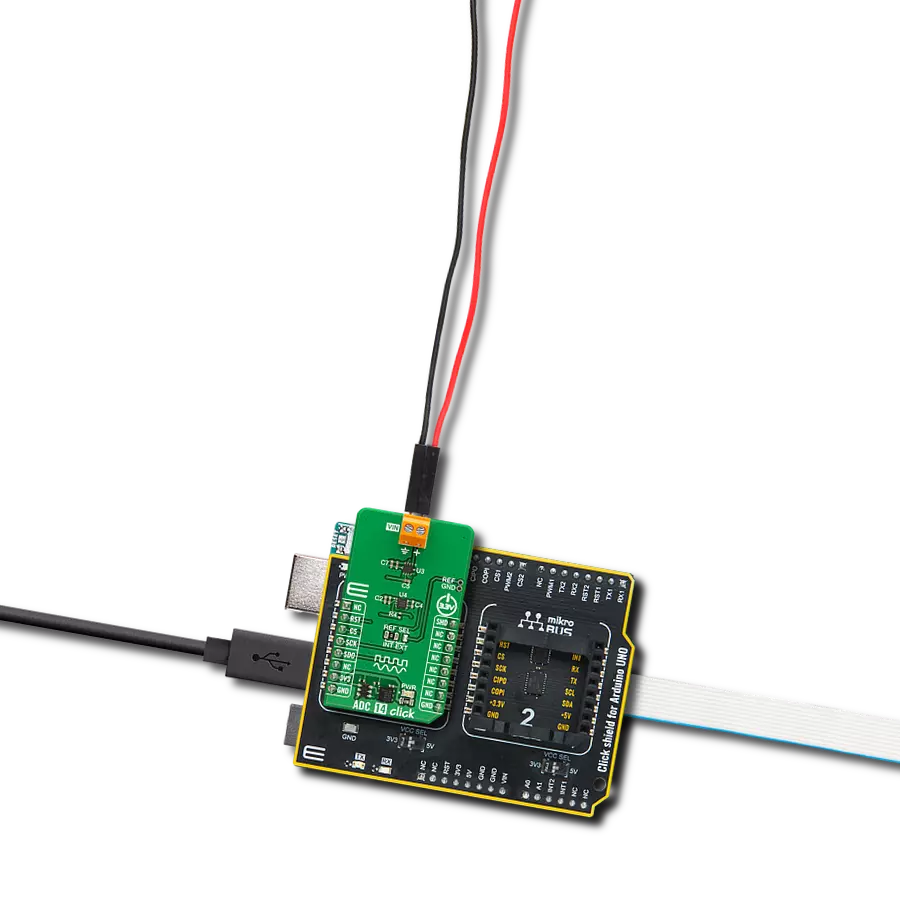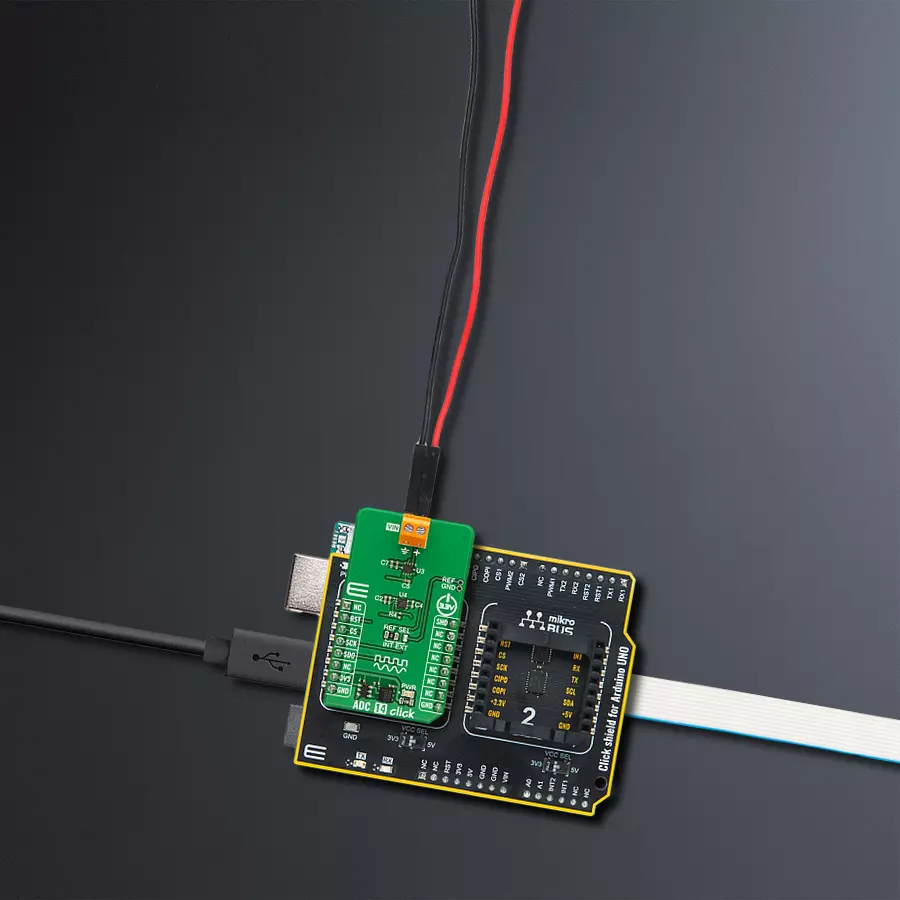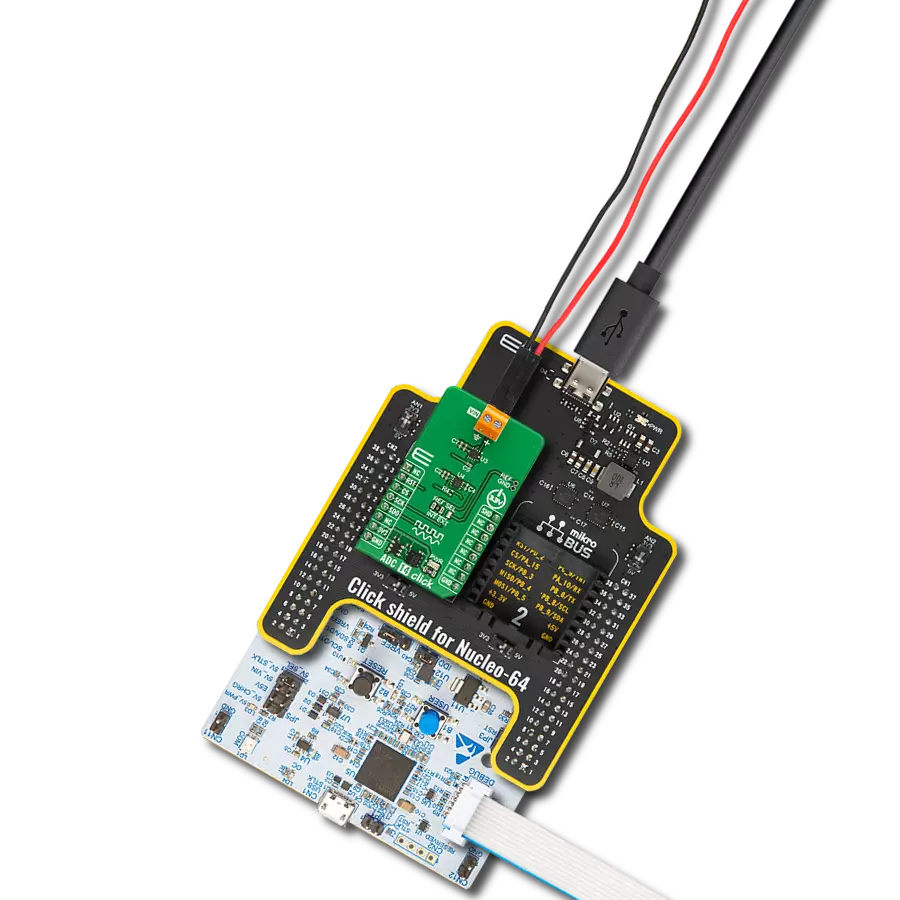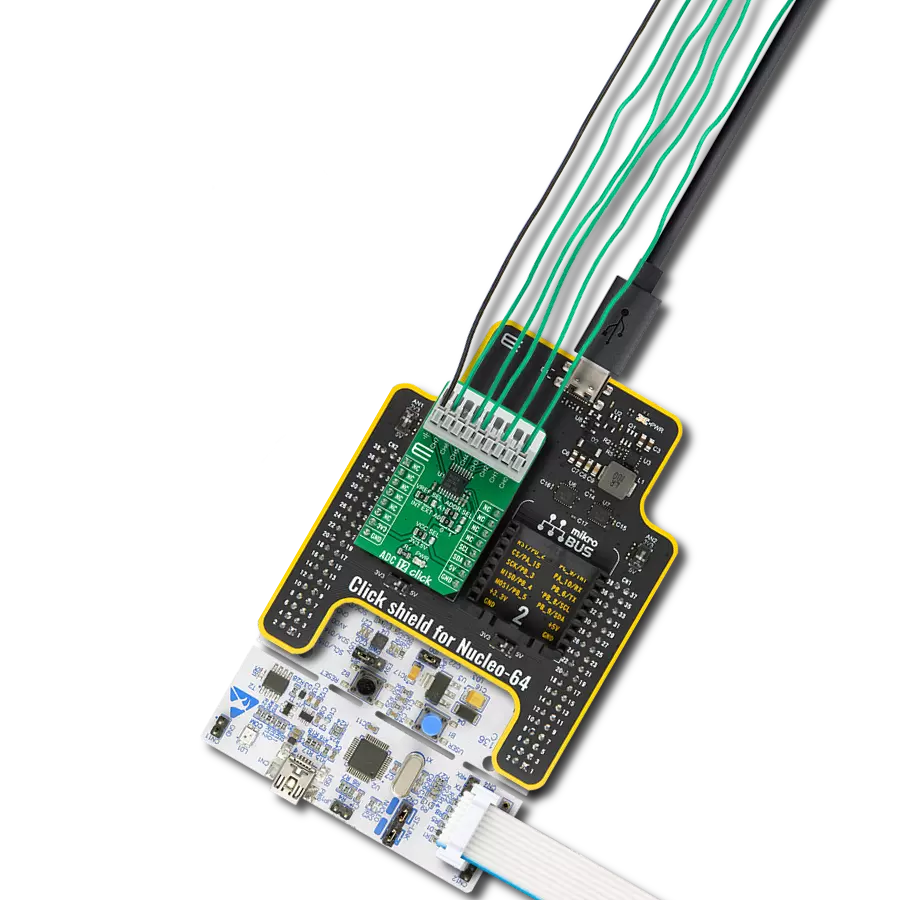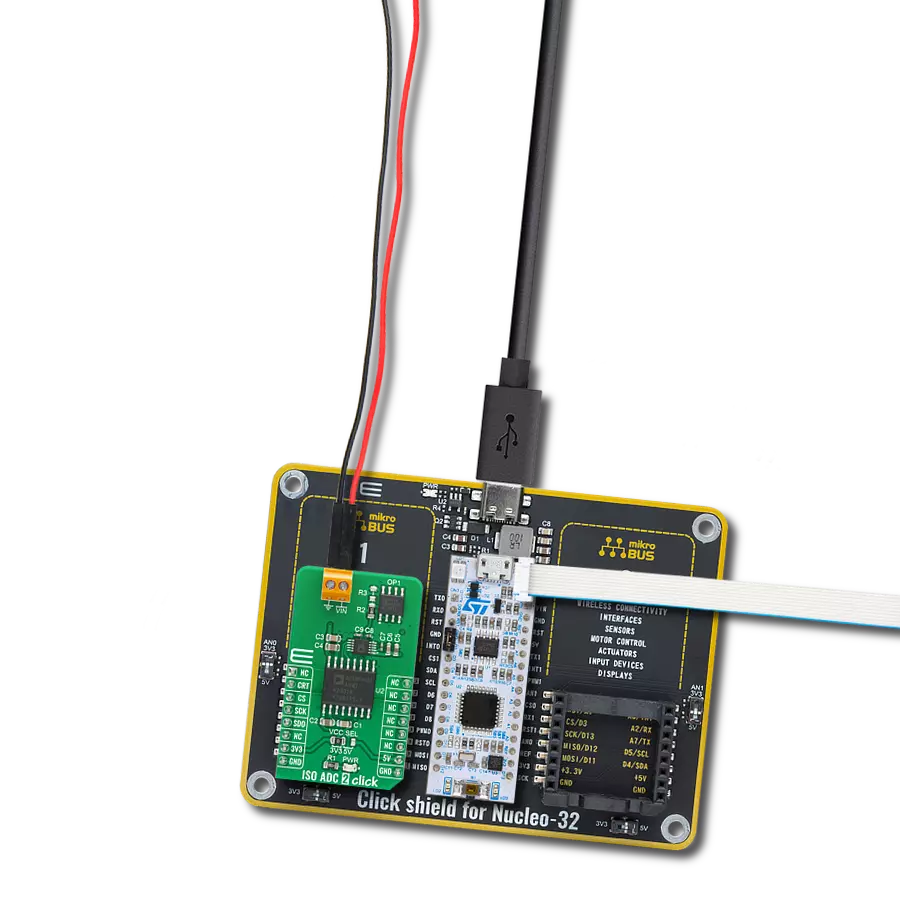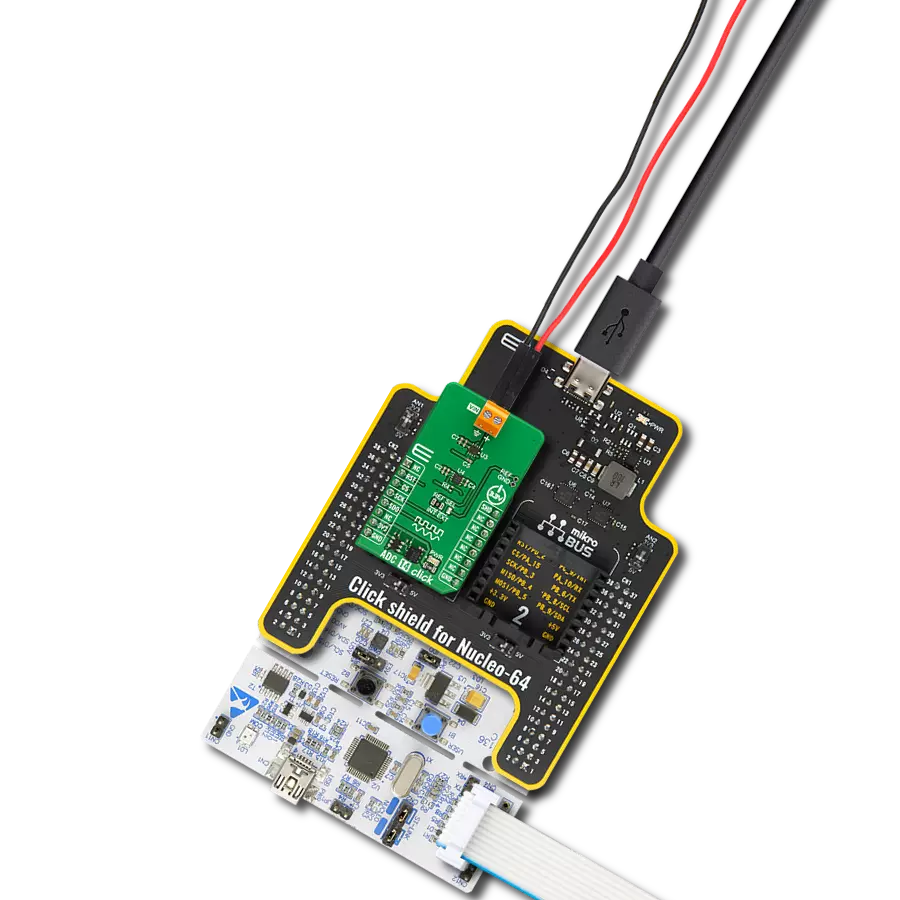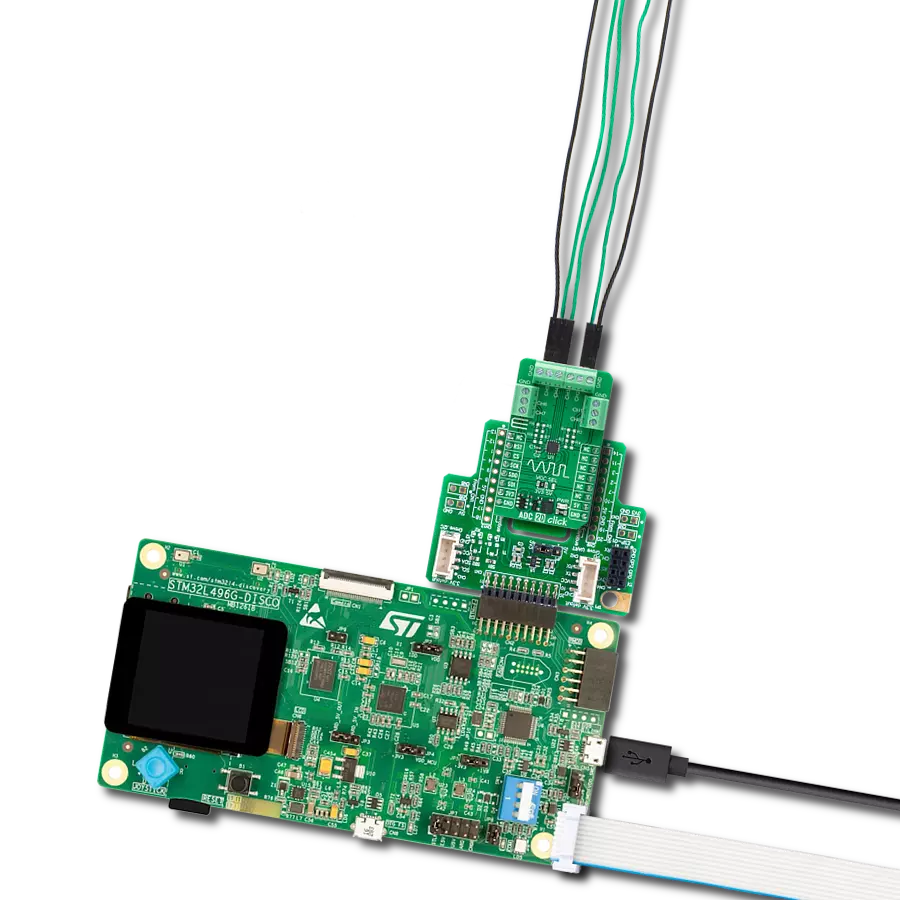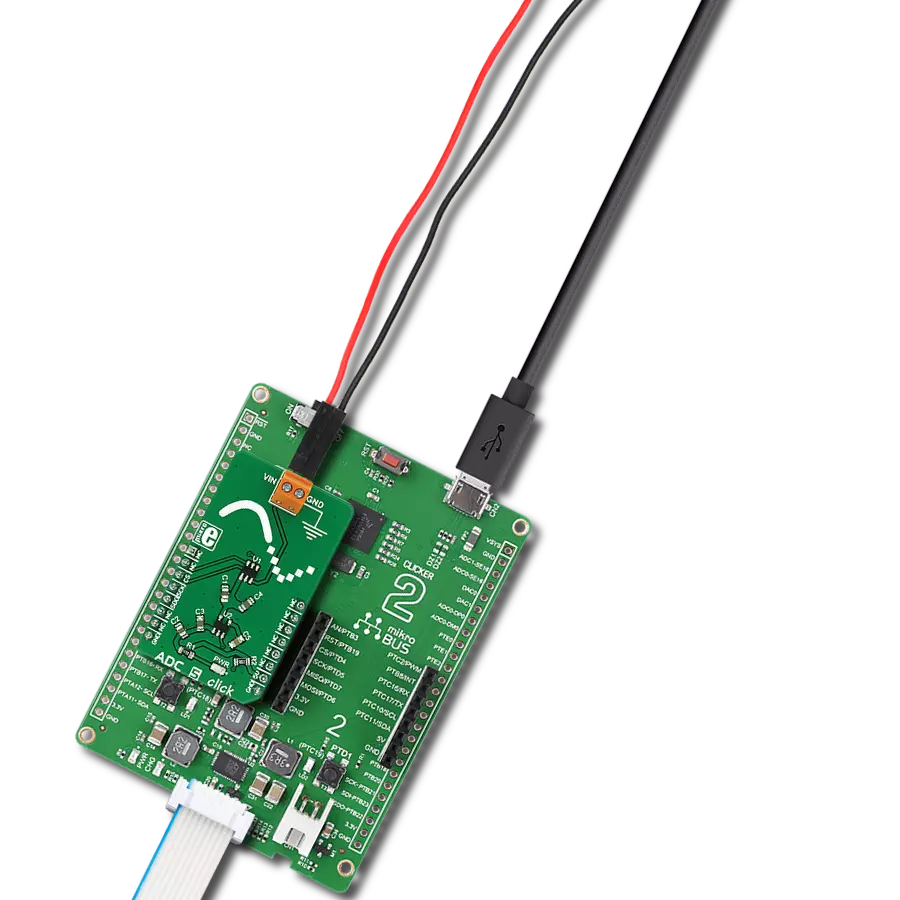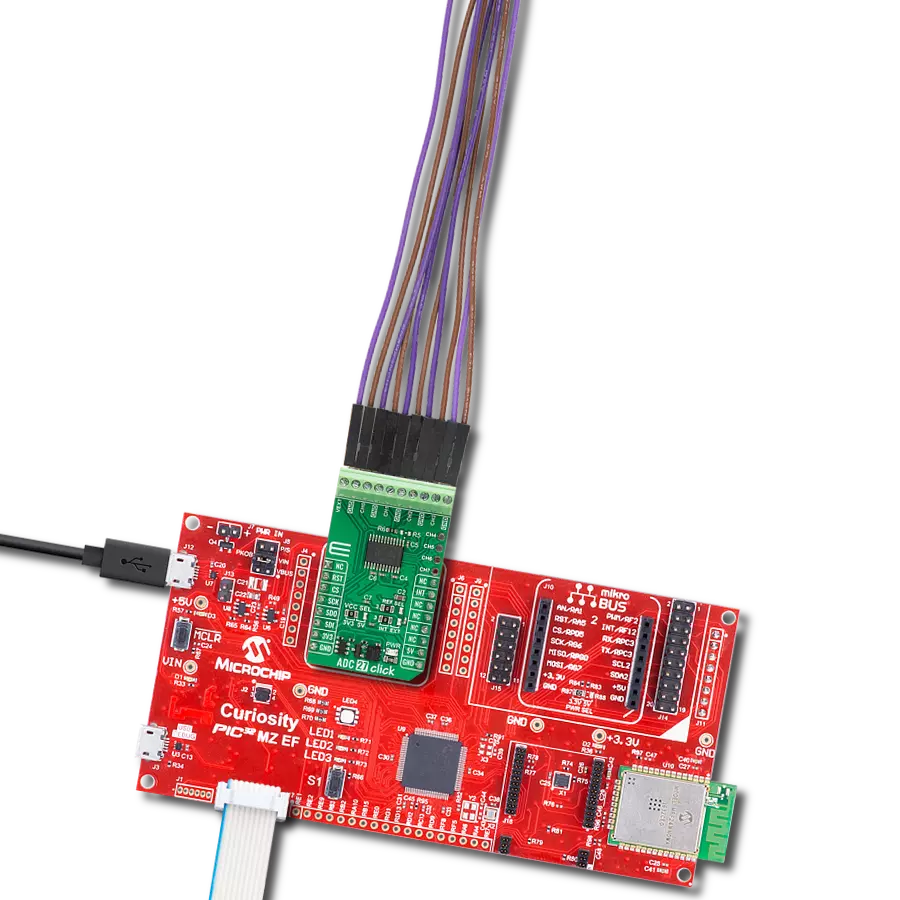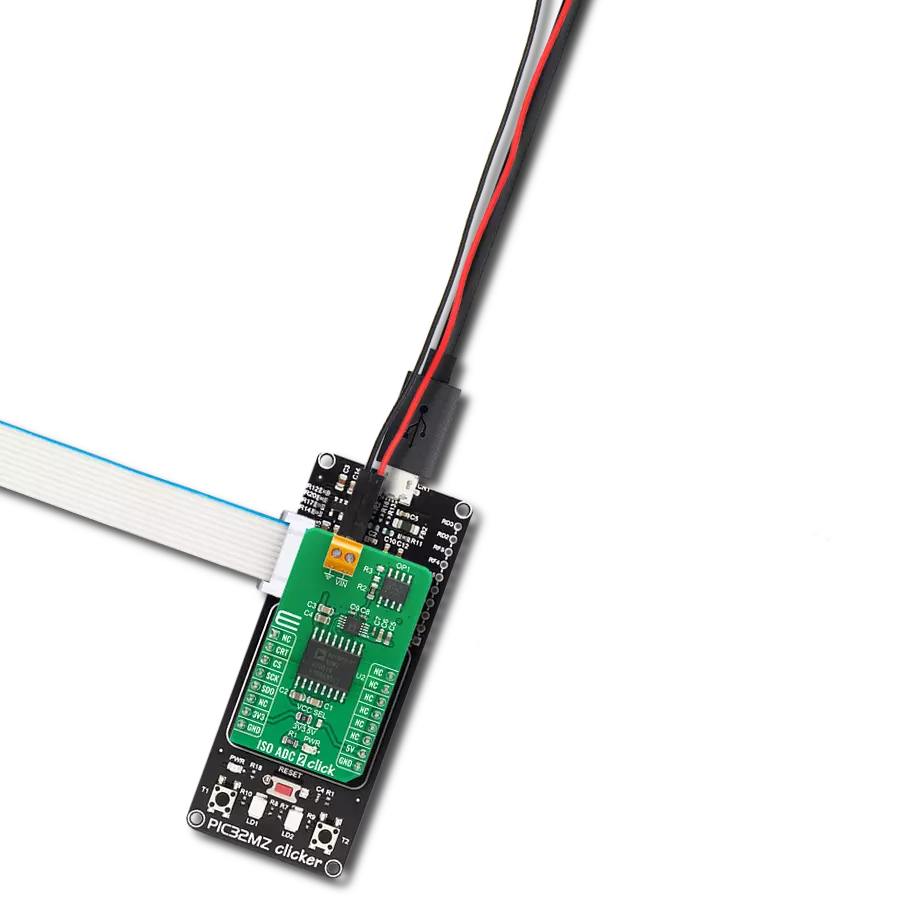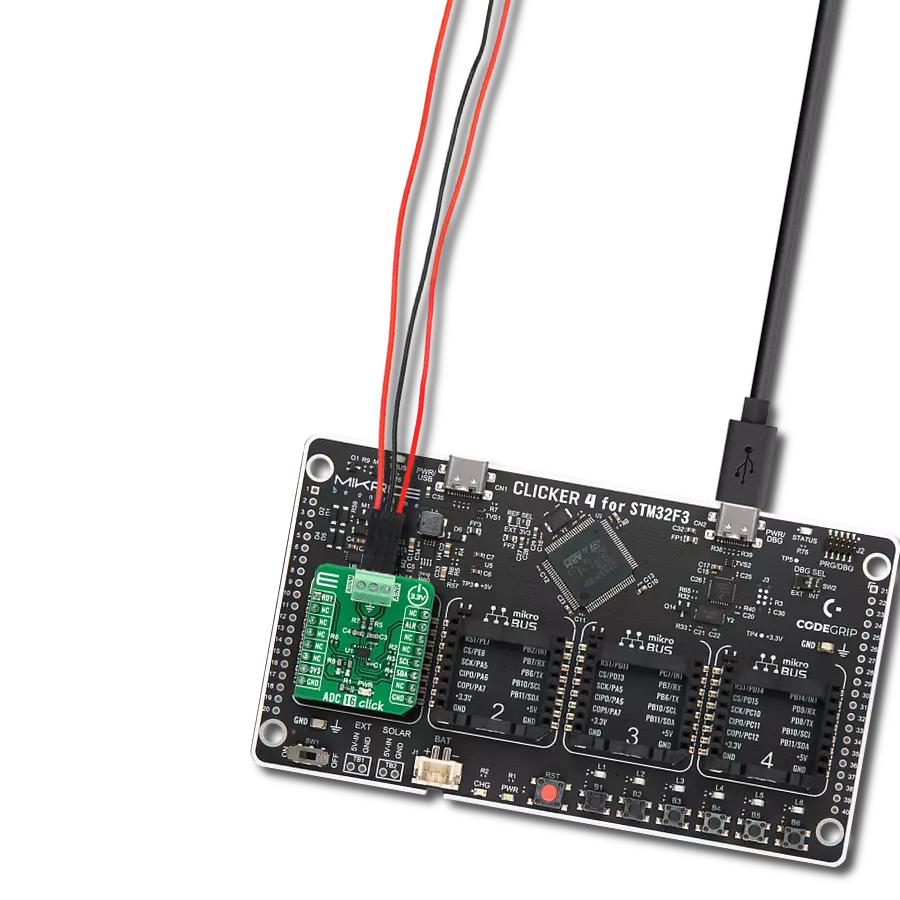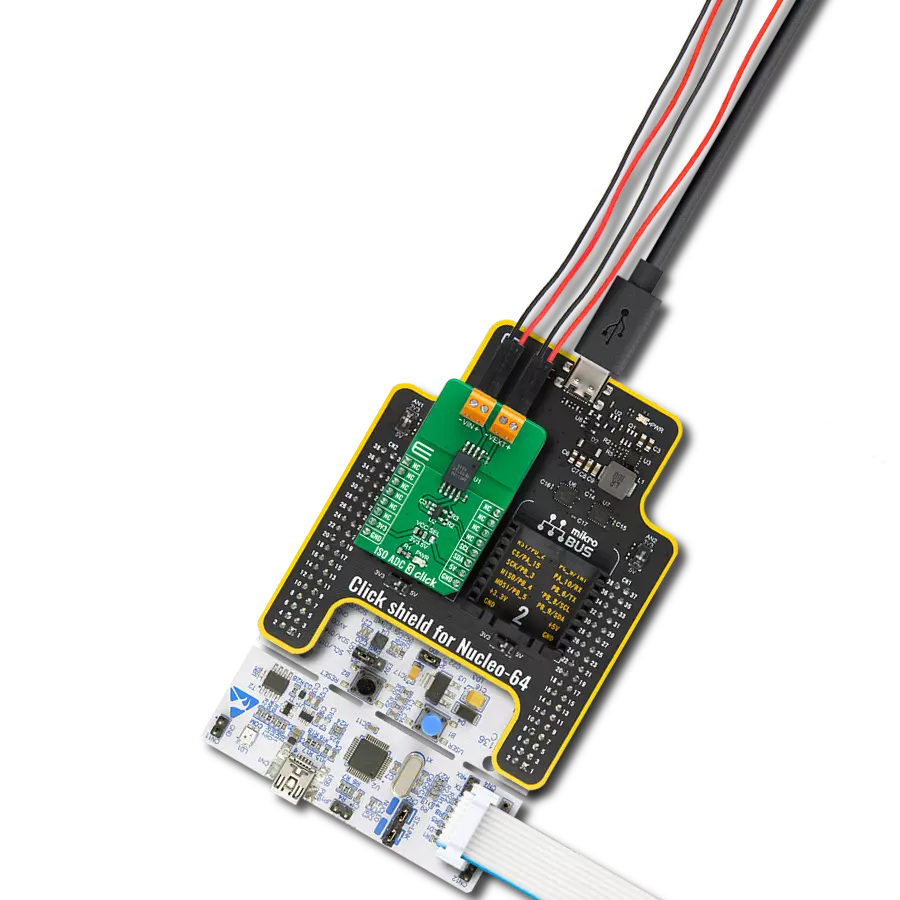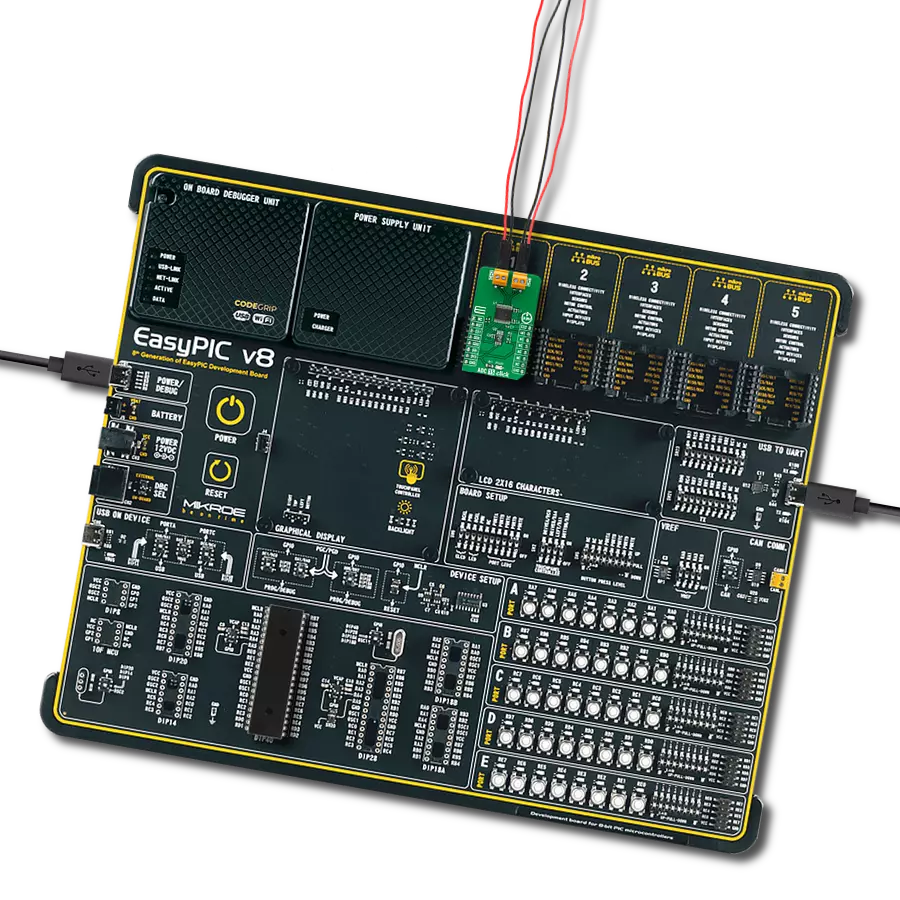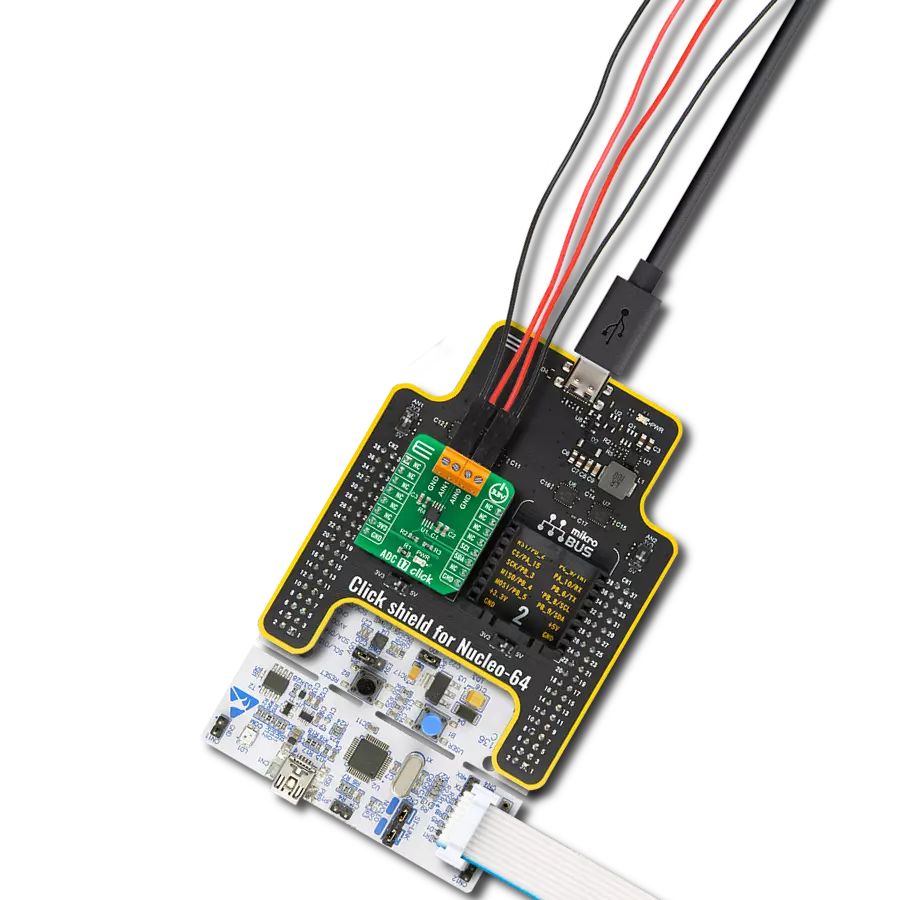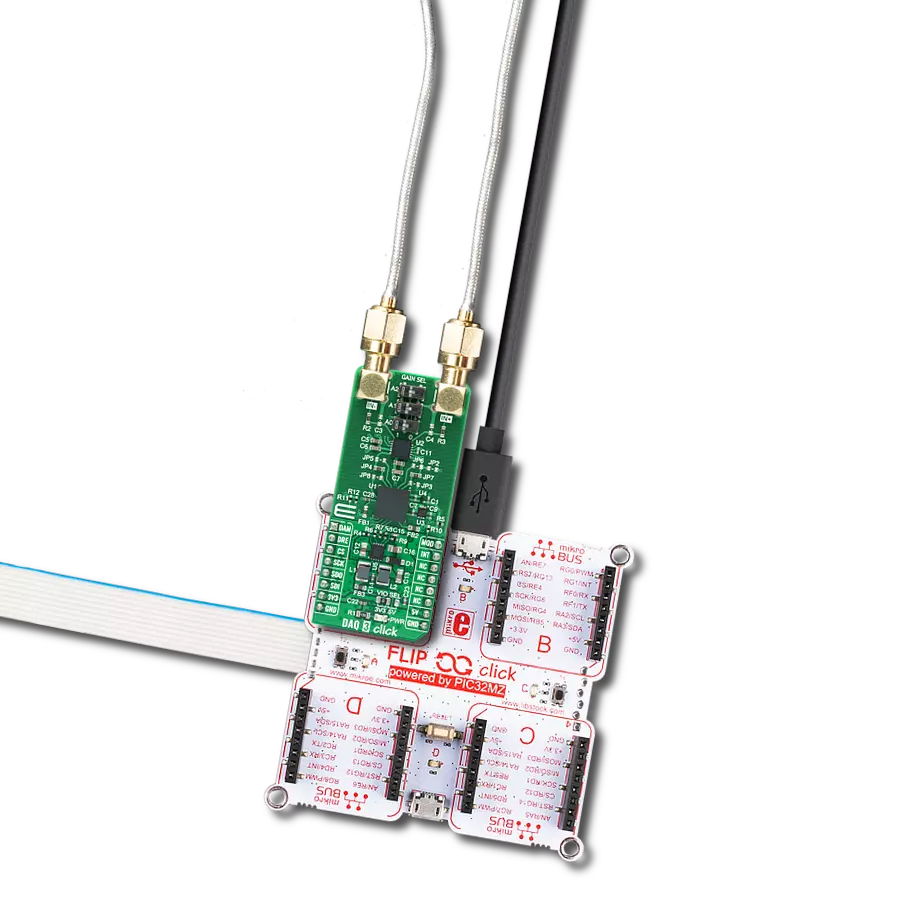Our ADC solution stands as a beacon of precision, seamlessly translating analog signals into a digital format with unmatched accuracy, ensuring your data speaks with clarity and depth.
A
A
Hardware Overview
How does it work?
ADC 14 Click is based on the MAX11108A, a low-power serial ADC from Analog Devices. This 12-bit ADC includes a full power-down mode and a fast wake-up for optimal power management, consuming only 6.6mW while sampling up to 3Msps. The low power consumption extends battery life, as it can go as low as 2.5μA/ksps and even lower in power-down mode. The MAX11108A samples from the analog input in the normal mode of operation while the device is powered up at all times, thereby achieving its maximum throughput rates. In addition, the ADC can operate with 14 cycles per conversion. The ADC 14 Click
accepts a full-scale input from 0V to the power supply or the reference voltage. The digital output corresponds to the analog input over the 2-pin screw terminal. ADC 14 Click can use internal or external as a reference voltage, which you can select over the REF SEL jumper (internal reference selected by default). The MCP1501, a high-precision buffered voltage reference from Microchip, provides a 2.048V internal reference voltage. In addition, you can use an external reference voltage, which you can connect over the REF header. ADC 14 Click uses a 3-Wire (read-only) SPI serial interface to communicate with the
host MCU, supporting up to 48MHz serial clock frequency. The SHD shutdown pin of the mikroBUS™ socket is used to shut down the MCP1501 with a Low logic state if the MCP1501 is not in use. This Click board™ can be operated only with a 3.3V logic voltage level. The board must perform appropriate logic voltage level conversion before using MCUs with different logic levels. Also, this Click board™ comes equipped with a library containing easy-to-use functions and an example code that can be used as a reference for further development.
Features overview
Development board
Arduino UNO is a versatile microcontroller board built around the ATmega328P chip. It offers extensive connectivity options for various projects, featuring 14 digital input/output pins, six of which are PWM-capable, along with six analog inputs. Its core components include a 16MHz ceramic resonator, a USB connection, a power jack, an
ICSP header, and a reset button, providing everything necessary to power and program the board. The Uno is ready to go, whether connected to a computer via USB or powered by an AC-to-DC adapter or battery. As the first USB Arduino board, it serves as the benchmark for the Arduino platform, with "Uno" symbolizing its status as the
first in a series. This name choice, meaning "one" in Italian, commemorates the launch of Arduino Software (IDE) 1.0. Initially introduced alongside version 1.0 of the Arduino Software (IDE), the Uno has since become the foundational model for subsequent Arduino releases, embodying the platform's evolution.
Microcontroller Overview
MCU Card / MCU
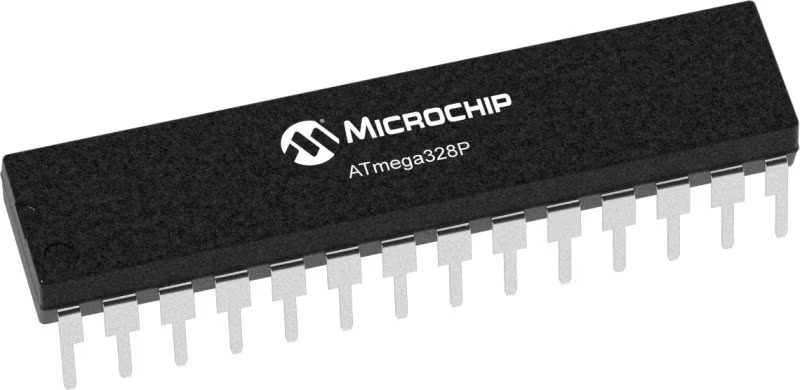
Architecture
AVR
MCU Memory (KB)
32
Silicon Vendor
Microchip
Pin count
28
RAM (Bytes)
2048
You complete me!
Accessories
Click Shield for Arduino UNO has two proprietary mikroBUS™ sockets, allowing all the Click board™ devices to be interfaced with the Arduino UNO board without effort. The Arduino Uno, a microcontroller board based on the ATmega328P, provides an affordable and flexible way for users to try out new concepts and build prototypes with the ATmega328P microcontroller from various combinations of performance, power consumption, and features. The Arduino Uno has 14 digital input/output pins (of which six can be used as PWM outputs), six analog inputs, a 16 MHz ceramic resonator (CSTCE16M0V53-R0), a USB connection, a power jack, an ICSP header, and reset button. Most of the ATmega328P microcontroller pins are brought to the IO pins on the left and right edge of the board, which are then connected to two existing mikroBUS™ sockets. This Click Shield also has several switches that perform functions such as selecting the logic levels of analog signals on mikroBUS™ sockets and selecting logic voltage levels of the mikroBUS™ sockets themselves. Besides, the user is offered the possibility of using any Click board™ with the help of existing bidirectional level-shifting voltage translators, regardless of whether the Click board™ operates at a 3.3V or 5V logic voltage level. Once you connect the Arduino UNO board with our Click Shield for Arduino UNO, you can access hundreds of Click boards™, working with 3.3V or 5V logic voltage levels.
Used MCU Pins
mikroBUS™ mapper
Take a closer look
Click board™ Schematic
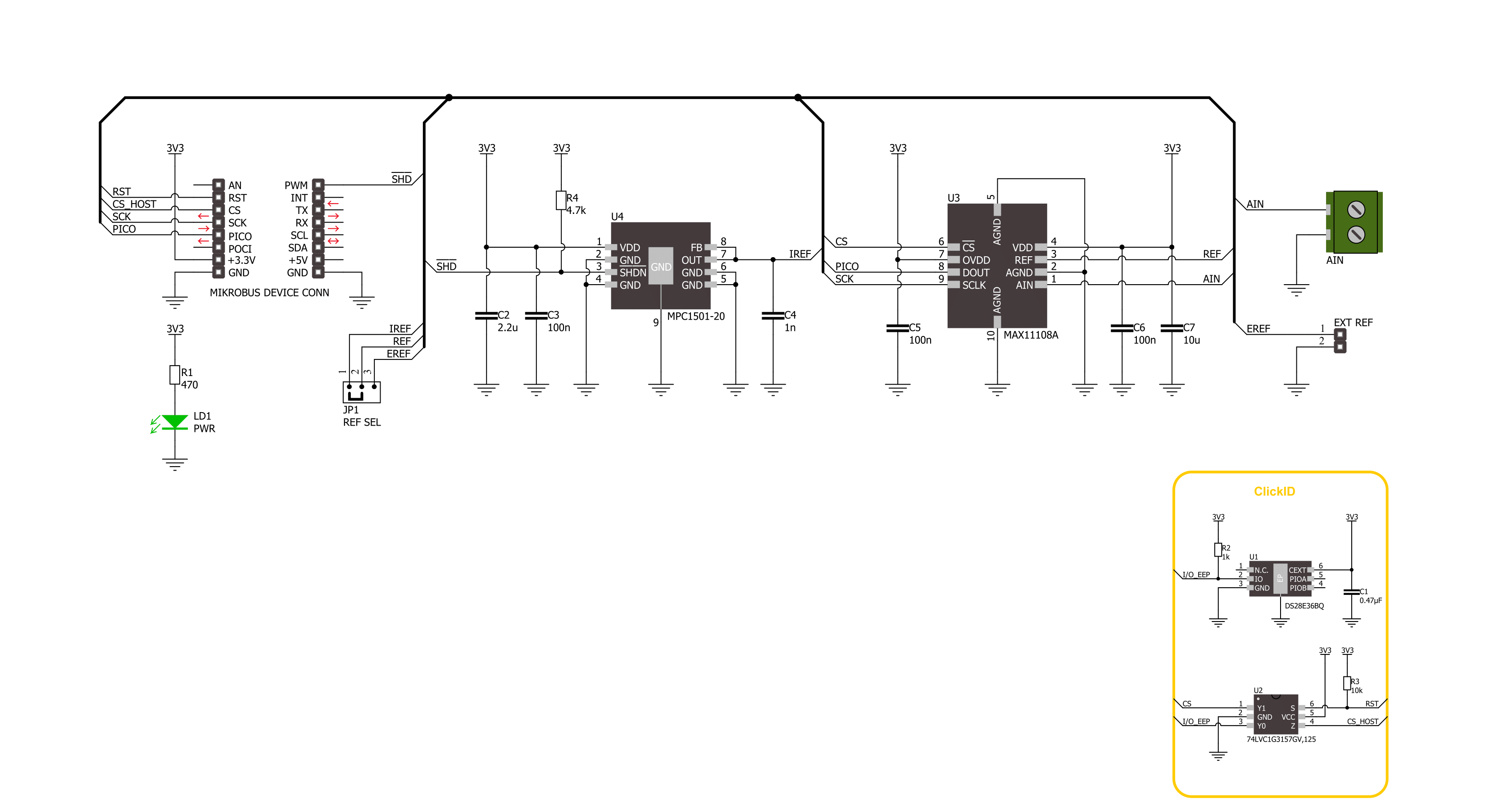
Step by step
Project assembly
Software Support
Library Description
This library contains API for ADC 14 Click driver.
Key functions:
adc14_get_voltage- ADC 14 get voltage function.adc14_read_conversion_data- ADC 14 read conversion data function.adc14_set_vref- ADC 14 set voltage reference function.
Open Source
Code example
The complete application code and a ready-to-use project are available through the NECTO Studio Package Manager for direct installation in the NECTO Studio. The application code can also be found on the MIKROE GitHub account.
/*!
* @file main.c
* @brief ADC 14 Click example
*
* # Description
* This example demonstrates the use of the ADC 14 Click board™
* by reading results of AD conversion by using SPI serial interface.
*
* The demo application is composed of two sections :
*
* ## Application Init
* Initialization of SPI module and log UART and enabled internal voltage reference.
*
* ## Application Task
* The demo application reads the voltage levels from analog input and displays the results.
* Results are being sent to the UART Terminal, where you can track their changes.
*
* @author Nenad Filipovic
*
*/
#include "board.h"
#include "log.h"
#include "adc14.h"
static adc14_t adc14;
static log_t logger;
void application_init ( void )
{
log_cfg_t log_cfg; /**< Logger config object. */
adc14_cfg_t adc14_cfg; /**< Click config object. */
/**
* Logger initialization.
* Default baud rate: 115200
* Default log level: LOG_LEVEL_DEBUG
* @note If USB_UART_RX and USB_UART_TX
* are defined as HAL_PIN_NC, you will
* need to define them manually for log to work.
* See @b LOG_MAP_USB_UART macro definition for detailed explanation.
*/
LOG_MAP_USB_UART( log_cfg );
log_init( &logger, &log_cfg );
log_info( &logger, " Application Init " );
// Click initialization.
adc14_cfg_setup( &adc14_cfg );
ADC14_MAP_MIKROBUS( adc14_cfg, MIKROBUS_1 );
if ( SPI_MASTER_ERROR == adc14_init( &adc14, &adc14_cfg ) )
{
log_error( &logger, " Communication init." );
for ( ; ; );
}
log_info( &logger, " Application Task " );
Delay_ms ( 100 );
}
void application_task ( void )
{
float voltage = 0.0;
if ( ADC14_OK == adc14_get_voltage( &adc14, &voltage ) )
{
log_printf( &logger, " Voltage : %.2f [mV]\r\n", voltage );
Delay_ms ( 1000 );
}
}
int main ( void )
{
/* Do not remove this line or clock might not be set correctly. */
#ifdef PREINIT_SUPPORTED
preinit();
#endif
application_init( );
for ( ; ; )
{
application_task( );
}
return 0;
}
// ------------------------------------------------------------------------ END
Additional Support
Resources
Category:ADC
